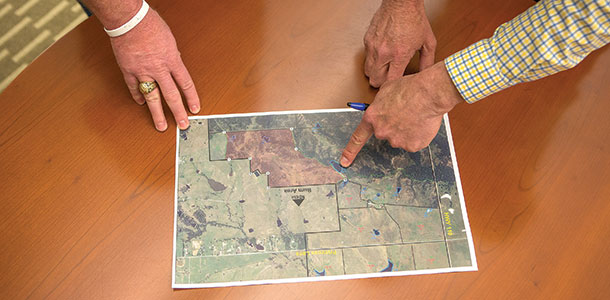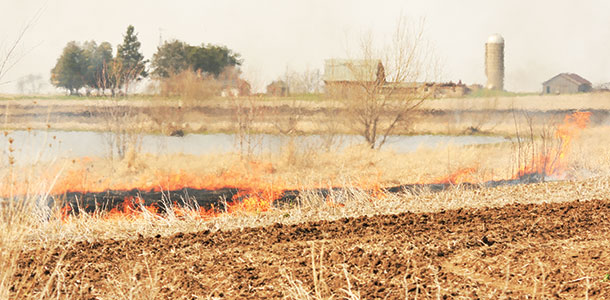All producers are familiar with grazing, and most utilize some variation of controlled grazing and rest in order to manage quality and utilization of native forage plants for livestock or wildlife.
However, at the mention of fire, the majority of producers think wildfire and believe there is no way to safely apply fire on their property.

Unfortunately, the lack of fire has created many negative issues for producers interested in managing for livestock and wildlife and has contributed to the spread of eastern red cedar and its pollen, which causes allergies for many people.
Fortunately, there is a way to safely apply prescribed fire to reduce or eliminate these problems.
Prescribed fire is a process and should be well planned and carefully applied under the right conditions to accomplish desired goals. Grazing and rest are major considerations for the successful use of prescribed fire.
If grazing causes an inadequate fuel load in grassland communities, burning is ineffective until stocking rate or grazing management is corrected. Therefore, the planning process for prescribed fire should begin at least one growing season in advance of implementation to ensure adequate fuel accumulation.
A prescribed burn plan is absolutely essential to safely and effectively conducting a burn. It identifies desired weather parameters for the burn and all steps to be completed before, during and after the burn.

Prescribed burning should never be attempted without a well-developed plan. “Prescribed” implies “prescription,” and a burn plan is the prescription for the burn. A good burn plan should contain the following:
- Basic information about the landowner/manager
- Description of the burn unit including the legal description or GPS coordinates as well as the pasture name and vegetation types, such as grass or timber
- Directions to the burn unit from the nearest town
- Objectives, or what is to be accomplished with the burn
- A notification list including names and phone numbers of rural fire department contacts and adjoining landowners
- Management steps needed prior to the burn such as grazing management modifications, brush pile management or mechanical treatments
- Types of firebreaks to be used (These can be existing ranch roads, disked or dozed strips, cultivated fields, etc.)
- Fuel conditions, such as continuity and estimated or measured amount of herbaceous vegetation on the day of the burn
- Desired ranges for weather conditions during the burn including relative humidity, wind speed, wind direction and temperature (Do not burn when weather conditions do not fall within desired ranges.)
- Plan of ignition (Describe how the burn unit will be ignited, i.e., which side will be lit first and in what sequence the remaining sides will be lit.
Also, describe how each crew will move around the burn unit as it is ignited. Draw this sequence in a map and put it in writing.)
- Smoke management issues such as smoke-sensitive areas within and around the burn unit, and steps needed to protect them, as well as listing the minimum category day or dispersion index required for the burn (Category day and dispersion index are forecasts of how well smoke will disperse up into the air and can be found on the National Weather Service or Ok-Fire.
- Pre-burn checklist of everything that needs to be done or accounted for on the day of the burn and before a match is lit
- Actual weather conditions before, during and following the burn
- A list of equipment needed for the burn
- The number of people needed to conduct the burn (Include names of each person helping with the burn.)
- A step-by-step contingency plan describing the proper procedures of controlling an escaped fire
- The preparer’s signature when the plan is completed
- A map of the burn unit
- An attached “prescribed burn notification form” (An example can be found in the Oklahoma Forestry Services Division publication “Notification Requirements and Considerations for Safe and Lawful Prescribed Burning in Oklahoma”
This list may seem intimidating, but once the work is completed and the burn unit boundaries remain the same, it is a simple matter of updating it for future burns.
For more information of prescribed fire, go online Oklahoma Prescribed Burn Association. Producers are fortunate to have several agencies that can assist with the development of a burn plan.
The Samuel Roberts Noble Foundation, the local Natural Resources Conservation Service, state university extension services, state departments of wildlife conservation and state forestry departments are examples of organizations with knowledgeable staff to assist. ![]()
PHOTOS
PHOTO 1: Russell Stevens
PHOTO 2: A property map of the unit for a controlled burn is essential for a prescribed burn plan. Photo courtesy of Noble Foundation.
PHOTO 3: Burns need to follow weather forecasts carefully, especially in the case of windy conditions. Photo courtesy of Thinkstock.








